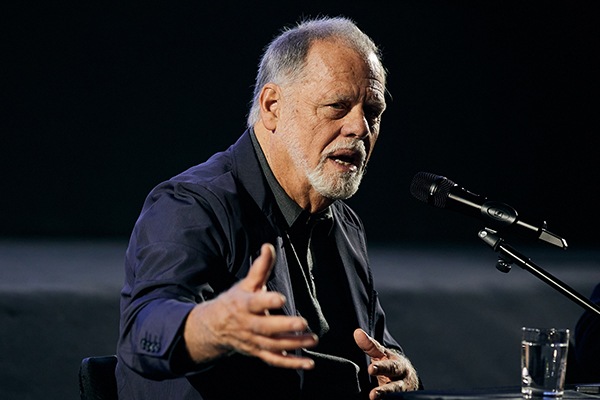Taylor Hackford :
“I'm from a rock generation.”
Posted on 19.10.2023
The director of Ray and An Officer and a Gentleman explains his method and his concerns about the future of Hollywood.
MOVEMENT
The camera should always be observing, not moving. I generally move with the actors. Take Ray, for example. For this film I had a three-phase movement strategy. The story begins with Ray Charles as a child, growing up in a poor but happy family; he can still see. The camera is on the ground, the family is moving around. I wanted to convey to the audience the fact that his life was stable. The second part is when he loses his sight, his life is jeopardised and it changes completely. That's when I start moving the camera; now his life is unstable. There's this tradition in the South of hanging bottles on trees to chase away evil spirits and at that moment the bottles start to slightly move.
Finally, when Ray starts using heroin and becomes addicted, he no longer has any stability, and his life takes a terrible turn for the worse. I film this with a handheld camera. Psychologically, Ray becomes detached, disconnected. It's subtle, and I think it helps the audience get a feel for the film.
In White Nights, I had the two best dancers in the world - Baryshnikov and Gregory Hines - and I put my camera down and shot without interruption. When you see a dance scene in a film and there are lots of cuts, you know they're not good dancers. You can't film this type of scene on your own, you need an exceptional team. You know, my mom was a waitress, a single mother, and I had a working-class upbringing. In all my films, my characters come from the same background; they want to succeed at all costs, they move around, which is probably why the feeling of movement is present in all my films.
 © Léa Rener
© Léa Rener
AN OFFICER AND A GENTLEMAN (1982)
This film talks about youth, whereas America, which is a great country, was founded by Puritans. In the 1920s and 1930s, movies were starting to become very sexy, and that's when the Hays Code was created, destroying the innocence of the United States. If you wanted to see sex, you had to see European films. I'm from a rock generation, but what was happening in life wasn't visible on screen, unlike in Europe. So when I made An Officer and a Gentleman, there was starting to be a certain turning point, but sex still wasn't present on the screen. I was making a film about young people from the working class who are all very good-looking, and that's all they think about - sex. To make An Officer and a Gentleman and not talk about it very openly was inconceivable.
In that sense it was controversial because we had sex scenes right from the start that reflected real life, but in the eyes of the studios, it's completely revolutionary, and it's the first time the studios have listened to a filmmaker on this issue. In my opinion, sex scenes have to serve the story in a film, otherwise there's no point to them. But if they're included, it's up to the director, and him alone, to decide how they unfold. I empty the set, the technicians disappear and I talk about it with the actors. Nowadays, since #MeToo and Weinstein, there are intimacy coordinators in Hollywood who are there to make sure that nothing inappropriate happens. I can't believe that's a good idea unless there are problems in the first place; it has to be the director who's filming.
UNION ORGANIZATION
In Hollywood, each union has its own method. The directors' union gets things done by negotiating. The writers, on the other hand, don't negotiate, they always go on strike and never obtain anything. They always say they've won things, but if they say that, it's because they can't accept that they've put people out on the street by going on strike. What's different is that now the actors are on strike. Netflix came along, seduced everyone by giving money up front, and everyone eventually realized that there were no more copyrights. That, plus artificial intelligence, is what we're all facing with this new industry.
Reported and edited by Charlotte Pavard

